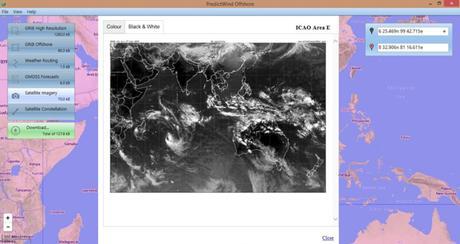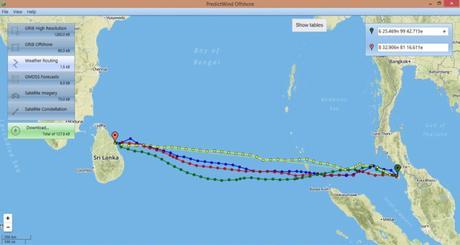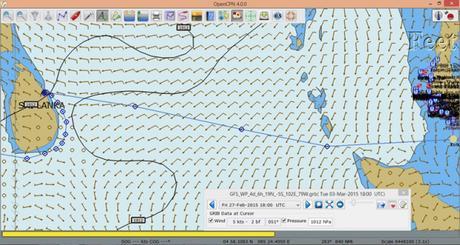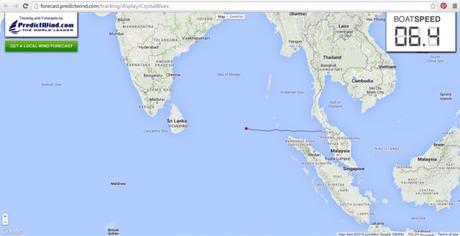
Not long before leaving Malaysia, we purchased an Iridium GO!. This was somewhat unexpected because Totem has long been a radio centric boat. Since we started cruising in 2008 we’ve relied solely on our HF radio for long distance communications: it has met our needs, we value the community of an informal radio net at sea, and we are grateful the safety net of land-based hams such as the awesome Pacific Seafarers Net.
What changed?
But this past year, paying close attention to the progress of boats along our intended route in the Indian Ocean, we were dismayed to hear how much trouble they were having connecting to land-based stations for the purpose of receiving updated weather data over PACTOR modems- to the point that we know radio-centric boats that relied upon sailing in company with those carrying satellite based systems on board so that they could to receive updated weather forecasts.
Weather data is critical for cruisers.
The waters around the south end of Africa are famous for monstrous wind and wave events. We don’t want to be without current weather data anywhere in the world, but if we had to pick spots we’re especially keen to have weather info on demand- it’s off southern Africa. South Africa has radio nets and hams, but connecting to the land stations for boats coming in from the east was a struggle. It was also difficult for boats heading into the Atlantic after rounding the Cape. Sailmail or Winlink, it didn’t seem to matter- both had issues with station access from that corner of the world.
Time to look beyond HF!
To solve our weather dilemma, for us the best solution is a combination of PredictWind and the Iridium GO!. We’ve used PredictWind for years on Totem, and they have apps designed specifically for working with an Iridium GO!. That’s actually very important: there’s a misconception that the GO! is like having a satellite based wifi-hotspot with you. It’s more complicated than that, because applications must be specifically designed for Iridium GO! to work with the unit. For the most part, these apps are tablet or smartphone based, but PredictWind works with the Iridium on a computer – and I want to be able to see and work with weather info on my bigger screen, not just a mobile one.
Before the passage.
The hardest part of the install was deciding where to put the base unit. Once we had that worked out, the rest was uncomplicated: Jamie mounted the external antenna on the top of our solar arch, and ran the cable back through the conduit already in place for our SilentWind turbine and solar panels. Easy.

We used the PredictWind Offshore App on a Windows laptop, with a Professional subscription. Prior to departure, Jamie spent time using routing tools in the PredictWind app to analyze our plan and found valuable insights that prompted us to adjust our route. Originally, the plan was to sail pretty close to a rhumb line through the northern Nicobar islands- something like the yellow track above. Based on what he learned thorugh the PredictWind routing algorithm, we decided to go farther south instead–between Sumatra and the south end of the Nicobars, which the routing showed to have a stronger favorable current flow. This had obvious benefits for our overall passage time, and helped us keep up our pace in very light air.
On the way to Sri Lanka
Thankfully, sailing from the Malay peninsula at this time of year is pretty benign. But “weather happens” and we wouldn’t rely on any forecast after a few days, and we expected up to 10 days on this passage. Going through the PredictWind app, we could download satellite images of the region, text based forecasts, and grib files. There are four different grib file types available (three are GFS based, and two of those are specialized PredictWind algorithms), and you can choose different viewers for the gribs: we like looking at it with a grib plugin on OpenCPN.

Winds in the Bay of Bengal are light at this time of year, and only get lighter until the end of the NE Monsoon in late March or April. As the forecast evolved during our voyage, the breezes held and we were able to knock three days off our expected time- getting in after seven days and a few hours.
Beyond weather.
The #1 reason we got the GO! is for weather data. But the GO! opens up a world of other features that I’m very happy to have on board.
Email. We used the (free) Iridium email app, and gave the address to a handful of friends and family to reach us while we were at sea. This worked tremendously well. I really liked the easy communication, and with a Bluetooth keyboard, could type as comfortably as at a laptop.
SMS. We tested this with a few friends, and it worked really well. It’s probably going to be the fastest / easiest way to get messages while we’re “out there”: there’s an audible ping from the Iridium when a new message comes in, so we get it much sooner than waiting for the next time we check our email. Happily, several other boats traveling loosely in company with us have recently purchased GO! units as well, so we can text back and forth anytime we want to get immediately in touch.
Twitter. The GO! made it very easy to keep tweeting away, and I had fun sending messages from our passage- and getting notifications for any pings, favorites, and retweets. It’s not set up for photos, just text.
Internet browsing. This only worked marginally for us. We simply found it to be very, very slow. I mean, it IS a satellite connection. We expected slow. But pages often timed out before loading, even with the super stripped down Opera “Mini” app cranked to minimize the pipe and remove images. But I have heard other boats having more success with this, so… well, we’ll keep trying.
Facebook. We should be able to post from the GO! to Totem’s facebook page, but unfortunately, this was a total fail. It could be user error; I’m still trying to figure this one out. I tested it before we left, and it worked just fine. Great, even! I had grand illusions of posting pictures to Totem’s Facebook page from the middle of the ocean. But as soon as we left, the posts failed to show up. I’m not sure what happened, as we see this working well for our buddies on Ceilydh, who are happily posting away as they sail towards us from Malaysia. Hopefully we can fix this for the next passage to Maldives.
Phone. Yes, you can make phone calls too! We didn’t, because our Unlimited data plan only includes 5 minutes of phone calls through the GO! per month, and we were hanging onto them “just in case.” But I’ll test it out soon. With a few extra bucks for the Unlimited Plus plan, you get 100 minutes. You pay a per-minute rate once you exceed the limit- this can add up fast.
Looking ahead.
One of the cool tools that PredictWind offers that we have yet to really take advantage of is a custom web page for tracking your boat, automatically updated with GPS positions from the Iridium GO! Friends and family can use it to follow your every move from afar (it updates every hour, automatically), and you can embed it into a web page. I’m looking forward to using this, but we won’t start until we’ve cleared the Lloyds London Market Exclusions list (aka, the piracy “High Risk Area”) for yachts. Unfortunately, the HRA box currently includes Maldives and Chagos, our next two destinations- so we’ll hold off on real time tracking for now, and begin using the page designed just for Totem from the Seychelles forward.

You should know:
PredictWind sells the GO! competitively with a cruiser-friendly package. They bundle the base unit with a variety of options we need, from an external antenna and varying lengths of cable to a SIM card. And trust me- you want that external antenna! Below deck, there’s not enough reception to be functional without the outside antenna. And yes, although the device is rugged (e.g., you can take it on deck), you wouldn’t want to leave it exposed to the elements- and we found it to be finicky without a full view of the sky. The GPS antenna on the device is not in the external antenna, however: it’s in the GO! base unit, so do give thought to where you mount it. For satellite visibility, putting the antenna on our solar arch is an easy solution.
Well connected readers know we love it when you read this on the SAILfeed website – thanks for kicking the change in our cruising kitty!

